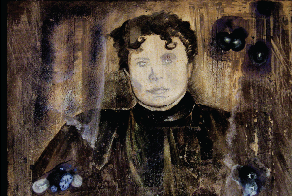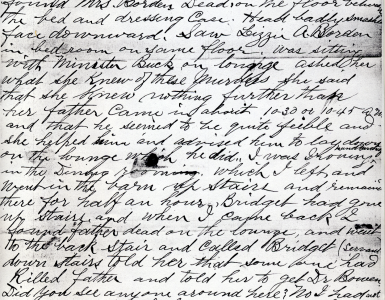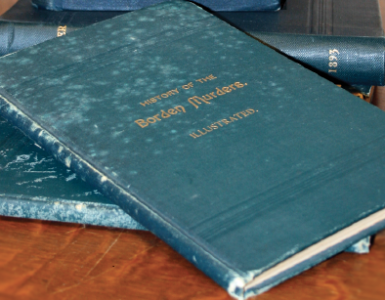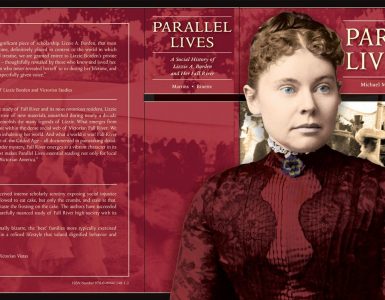by Mark Venaglia
First published in Winter, 2009, Volume 6, Issue 3, The Hatchet: Journal of Lizzie Borden Studies.
There exists a staggering number of aspects to Lizzie Borden. I have come to appreciate her as the patron saint of those who have suffered egregious injustice by their parents. In our 21st century, a socially open and far more functional time than Ms. Borden’s earlier era, many people endeavor to acknowledge their great personal atrocities—a painful, but necessary, journey as we move forward as a species. Perhaps this is part of Lizzie’s continued, and growing, appeal.
In the 1980s, The Hudson Theater Guild premiered a post-modern theatrical version of Lady Borden. I was the apprentice to the set designer for this landmark production, my first encounter with Borden passion. Every evening, I saw lines of people attempting admission into the tiny theater. Though scaled down, its envious stage proportions equaled the best Broadway theatres—as the designer murmured at each occasion when his setting of biblical proportions was rescaled to the Off Off Broadway budget.
Intriguing and unsettling, this show introduced me to a theatrical conclusion far different than the choral showstoppers, spectacularly resolved, to which I was accustomed. Her parent’s deaths were too grizzly for me to hold in my long-term memory. But the amount of devotion I saw to this historical figure still impressed me.
The contemporary portrait reproduced on this cover of The Hatchet was commissioned by a great friend from those early Manhattan days—as a Christmas gift to his life partner. This project became an opportunity for me to turn the standard clichéd portrait exclamation inside out: “The eyes followed me all around the room.” As viewers move around the work, it transforms, revealing numerous visual facets in tribute to Lizzie’s extensive psychological effects.
Installation art requires that we move through and around each pile of genius in order to have the full art experience. I apply the same dynamic, multiviewing aesthetic to all art. Traditional tintypes and daguerreotypes, perhaps enhanced by far more sophisticated halogens and LEDS, generate a remarkable variety of effects.
When viewed from various slowly moving angles, most ancient photographic images become more 3D and alive than any photographs printed in our lifetimes. I continue exploring the translation of this experience into contemporary art, especially enjoying how19th century photographs, considered to be the replacement for pigment paintings to the hip of that period, now form the basis of my contemporary approach to . . . new paintings.
The literal layers contained in this specific portrait represent the magnitude of Lizzie as social and cultural icon. Her face morphs from raw silver to gleaming copper, and then to an orange, nearly flesh-like tone. Her eyes range from corpse stare to piercingly alive—all by using acrylic versions of the once highly toxic materials in a typical albumen print. My concept of growing the beautiful imperfections of traditional daguerreotypes, in fact exaggerating and even featuring these blemishes, is greatly enhanced by new and environmentally respectful materials. Instead of struggling with muslin or canvas, typical to my work, the hard surface of the FSC certified wooden box permits me to literally polish the multiple layers of casein fresco and iridescent acrylic. I used 0000 steel wool purchased from my local hardware store.
 Human beings’ expressions are remarkably varied. Within a few seconds, each fluctuation in emotion or intellect registers in the eyes, and the limitless angles of either mouth corner. By painting with transparent mediums, reflective layers and light absorbing paints, I hope to capture in all of the portraits I create some of the remarkable variety of expression I see.
Human beings’ expressions are remarkably varied. Within a few seconds, each fluctuation in emotion or intellect registers in the eyes, and the limitless angles of either mouth corner. By painting with transparent mediums, reflective layers and light absorbing paints, I hope to capture in all of the portraits I create some of the remarkable variety of expression I see.
I’ve recommended to the gentlemen who commissioned Lizzie: try viewing her during a candlelight dinner. The painted details are actually enhanced at the loss of conventional light. And art can be the perfect excuse to reintroduce romance to any 10-year marriage.
It is an honor for my work to be introduced to the savvy readers of The Hatchet. The kind of people who covet paintings of sea otters balancing oysters on their furry little chests or dolphins peeking above and below sea level have a certain intellectual capacity very different from Lizzie Borden aficionados. I welcome your appraisals of my visual offerings and the intellectual, spiritual subjects I attempt to render for a contemporary society with late 19th century admiration.
NOTE: As a special offer to Hatchet readers, the I am offering 10” x 8” portraits of your favorite personality (including your own) for $750, reduced from the LA rate of $1,200.
Using daguerreotypes and tintypes—especially their amazing discolorations—as references from my own portraits, is something I have barely scratched the surface of, and I believe that is a pun. Human images vanish and reappear via the early mercury plate process. I continue to recreate this shimmery, gaslight effect with contemporary, earth friendly materials.
http://web.mac.com/runbilly/iWeb/markv/Portraits.html







